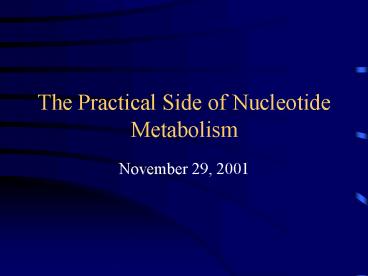The Practical Side of Nucleotide Metabolism - PowerPoint PPT Presentation
1 / 26
Title:
The Practical Side of Nucleotide Metabolism
Description:
Anti-Viral Therapies. HIV- Human Immunodeficiency Virus. HSV- Herpesvirus ... Acyclovir as an Anti-HSV Agent. Acyclovar (acycloguanosine)- purine analog ... – PowerPoint PPT presentation
Number of Views:133
Avg rating:3.0/5.0
Title: The Practical Side of Nucleotide Metabolism
1
The Practical Side of Nucleotide Metabolism
- November 29, 2001
2
The Plan for Today
- Finish up Tuesdays Leftovers
- Brief Explanation of how dUMP is converted to
dTMP - Some clinically relevant treatments based on
these pathways that are used to combat - Cancer
- Viral Infections
3
Beyond AMP, GMP and UMP
Purine Biosynthesis
Pyrimidine Biosynthesis
GMP
AMP
UMP
But other forms of these nucleotides are needed
4
Two Problems
- These are monophosphates (i.e. GMP)- we need
triphosphates (i.e. GTP) for both DNA and RNA
synthesis - These are ribonucleotides- thats fine for RNA
but we also need to make DNA
Synthesis of ribonucleotides first supports the
RNA world theory
5
Specific Kinases Convert NMP to NDP
Nucleoside Monophosphates
Nucleoside Diphosphates
Monophosphate Kinases
NMP
NDP
- Monophosphate kinases are specific for the bases
Adenylate Kinase
Guanylate Kinase
6
Conversion of Ribonucleotides to
Deoxyribonucleotides
BASE
BASE
Ribonucleotide Reductase
Deoxyribonucleoside
Ribonucleoside
Somehow we need to get rid of this oxygen
7
Ribonucleotide Reductase
- Catalyzes conversion of NDP to dNDP
- Highly regulated enzyme
- Regulates the level of cellular dNTPs
- Activated prior to DNA synthesis
- Controlled by feedback inhibition
8
dNDP to dNTP (the final step)
- Once dNDPs are generated by ribonucleotide
reductase a general kinase (nucleoside
diphosphate kinase) can phosphorylate to make the
dNTPs
Nucleoside diphosphate kinase
CDP
CTP
ATP
dGDP
dGTP
9
Beyond dGTP, dATP and dUTP
- So far weve made GTP, ATP, and UTP for
incorporation into RNA - Also dGTP and dATP for incorporation into DNA
- We still need dCTP for both RNA and DNA
- We also need to generate dTTP for DNA
10
Synthesis of UTP/CTP (Easy Problem)
UMP
UDP
UTP
ATP
ATP
Nucleotide Diphosphokinase
ATP Glutamine
CTP
11
Synthesis of TTP(Hard Problem)
Thymidylate Synthase
dUMP
dTMP
CH3
- Methyl group is provided by N5,N10-Methylene
tetrahydrofolate - Dihyrofolate reductase recharges the
Dihydrofolate to N5,N10-Methylene tetrahydrofolate
12
Role of Folate in dTMP Synthesis
Dihydrofolate Reductase
13
The Plan for Today
- Finish up Yesterdays Leftovers
- Brief Explanation of how dUMP is converted to
dTMP - Some clinically relevant treatments based on
these pathways that are used to combat - Cancer
- Viral Infections
14
Antimetabolites
- Often drugs that inhibit cell growth are used to
combat cancer - Many of these compounds are analogues of purine
and pyrimidine bases or nucleotides - Many of these drugs must be activated by cellular
enzymes - They affect nucleic acid synthesis and tumor
cells tend to be more susceptible since they are
dividing more rapidly
15
6-Mercaptopurine (6-MP)
- Purine Analogue
- Used clinically to combat childhood leukemia
- Since 1963 cure rate has increased from 4 to
greater than 80
Inhibitor of Committed Step in de novo Purine
Biosynthesis
6-mercaptopurine ribonucleotide
PRPP 6-MP
This reaction is more active in tumor cells
16
Cytosine Arabinose (araC)
- Metabolized to cytosine arabinose 5-triphosphate
(araCTP) - Analogue of CTP
- Incorporated into DNA and inhibits chain
synthesis - Used extensively for acute leukemias
Cytosine Ribose
Cytosine Arabinose
Differs only in the sugar
17
Antifolates
- Antifolates interfere with formation of
dihydrofolate which is required for - dTMP synthesis (today)
- de novo purine biosynthesis (yesterday)
Thymidylate Synthase
dUMP
dTMP
Dihydrofolate
N5,N10-Methylene tetrahydrofolate
Tetrahydrofolate
18
Antifolate Agents Mimic Folate
19
Hydroxyurea
- Specifically inhibits ribonucleotide reductase
NDP
dNDP
- Inhibits DNA synthesis without affecting RNA
synthesis or other nucleotide pools - Cleared from the body rapidly so not used
extensively in the clinic
20
Practical Considerations
- Most of these agents are used in combination
therapies - Many need to be processed in cells to create the
active compound - Often are not specific for tumor cells but rather
for rapidly dividing tissues - Multiple modes of drug resistance can and do
develop (Specific or General)
21
Example of Specific Drug Resistance Methotrexate
- Methotrexate works by inhibiting the function of
dihydrolfolate reductase (DHFR) - Cells develop ways to avoid this block
- Mutations in DHFR that make it bind less tightly
to MTX - Amplication of the DHFR gene (more enzyme
activity)
22
Anti-Viral Therapies
- Target virally infected cells
- Take advantage of aspects of viral metabolism
that differ from normal cellular metabolism
HIV- Human Immunodeficiency Virus
HSV- Herpesvirus
23
AZT as an Anti-HIV Agent
- Azido-3-deoxythymidine
- Pyrimidine Analogue
- HIV is a retrovirus
- RNA genome that is reverse-transcribed to DNA
- Viral polymerase is inhibited by AZT
DNA
RNA
Protein
24
Acyclovir as an Anti-HSV Agent
- Acyclovar (acycloguanosine)- purine analog
- Needs to be phosphorylated to be activated
- A viral thymidine kinase catalyzes this reaction
- No similar cellular kinase exists
- Activated form is a potent DNA polymerase
inhibitor
25
The BIG Picture
- GMP, AMP, UMP on..
- Generation of dTMP
- Common features of clinically relevant
antimetabolites/antifolates - Antiviral agents- how are they specific for the
virally infected cells?
26
(No Transcript)































